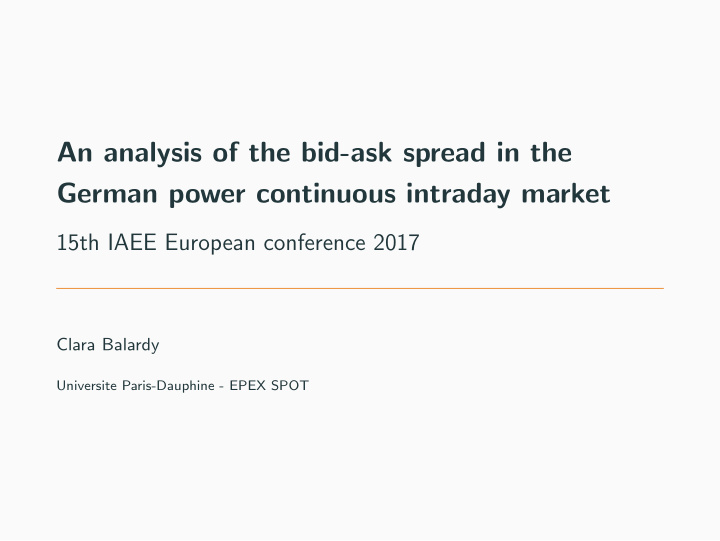



An analysis of the bid-ask spread in the German power continuous intraday market 15th IAEE European conference 2017 Clara Balardy Universite Paris-Dauphine - EPEX SPOT
Table of contents 1. Context 2. Dynamic analysis 3. Econometric analysis 4. Conclusion 1
Context
The power spot market in Germany 2
The orders book Ask Bid Quantity Price Price Quantity 20 35 32 4 5 36 31 15 12 39 29 7 3 42 28 9 25 30 3
The bid-ask spread Ask Bid Quantity Price Price Quantity 20 35 32 4 5 36 31 15 12 39 29 7 3 42 28 9 25 30 The bid-ask spread is the difference in price between the lowest price for which a seller is willing to sell a MWh of power and the highest price that a buyer is willing to pay for it. 4
The market depths Ask Bid Quantity Price Price Quantity 20 35 32 4 5 36 31 15 12 39 29 7 3 42 28 9 25 30 Market depths are the total volume available in the orders book on the ask (sell depth) and the bid (buy depth) side. 5
Research questions • How are the bid-ask spread and the market depths behaving over the trading session? • What are the determinants of the bid-ask spread on the market? 6
Dynamic analysis
Empirical strategy How are the bid-ask spread and the market depths behaving over the trading session? • Dynamic analysis • Period: 1st of June to 15th of November 2015 • Data: German intraday continuous orders books (EPEX SPOT) • Granularity: microseconds 7
Results Figure 1: Evolution of the best buy and Figure 2: Bid-ask spread over an average best sell prices over a trading session trading session 8
Results Figure 3: Evolution of the best buy and sell Figure 4: Sell depth over an average depths over a trading session trading session 9
Econometric analysis
Empirical strategy What are the determinants of the bid-ask spread on the market? • Panel data econometrics / FGLS estimator • Period: 1st of June to 15th of November 2015 • Data: German intraday continuous orders books + trades books + aggregate curves of the German Day-Ahead Market (EPEX SPOT) + load (EEX) + fundamentals forecasts and generation (EEX, EuroWind) • Granularity: trading session 10
Empirical strategy BAS = β 1 ✶ wkd + β 2 L + β 3 WAP + β 4 AM + β 5 V + β 6 ∆ W + + β 7 ∆ S + + β 8 ∆ W − + β 9 ∆ S − + β 10 ES + β 11 EP ✶ wkd : dummy variable for week-end L: load (MWh) WAP: weighted average price ( e / MWh) AM: number of active members V: volume of the market (GWh) ∆ W + : Positive solar forecast error (GWh) ∆ S + : Positive solar forecast error (GWh) ∆ W − : Negative wind forecast error (GWh) ∆ S − : Negative solar forecast error (GWh) ES: Elasticity of the supply curve of the DAM EP: Elasticity of the purchase curve of the DAM 11
Empirical strategy BAS = β 1 ✶ wkd + β 2 L + β 3 WAP + β 4 AM + β 5 V + β 6 ∆ W + + β 7 ∆ S + + β 8 ∆ W − + β 9 ∆ S − + β 10 ES + β 11 EP ∆ W = W − ˆ W ∆ W + = max { ∆ W , 0 } ∆ W − = min { ∆ W , 0 } W: wind generation (GWh) ˆ W : wind forecast (GWh) 12
Empirical strategy BAS = β 1 ✶ wkd + β 2 L + β 3 WAP + β 4 AM + β 5 V + β 6 ∆ W + + β 7 ∆ S + + β 8 ∆ W − + β 9 ∆ S − + β 10 ES + β 11 EP 13
Results Estimate Std. Deviation Dummy week-end 0.074 ∗∗∗ 0.004 Load (GWh) -0.007 ∗∗∗ 0.0002 WAP ( e / MWh) 0.005 ∗∗∗ 0.0001 IDM volume (GWh) 0.087 ∗∗∗ 0.001 Number of active members -0.008 ∗∗∗ 0.0001 Positive solar FE (GWh) 0.0247 ∗∗∗ 0.001 Positive wind FE (GWh) 0.004 ∗∗∗ 0.001 Negative solar FE (GWh) -0.005 ∗∗∗ 0.001 Negative wind FE (GWh) 0.022 ∗∗∗ 0.001 Elasticity sell side 6.546 ∗∗∗ 0.110 Elasticity buy side 1.765 ∗∗∗ 0.048 Observations 3,713 R 2 0.233 14
Conclusion
Key take aways • The bid-ask spread has a ”U-shape” over the trading session • The spread is negatively correlation with the liquidity and positively with the volatility • The liquidity is the main driver of the German intraday power market’s spread 15
Thank you! Please, feel free to share your comments or suggestions. Contact: clara.balardy@dauphine.eu 16
Recommend
More recommend